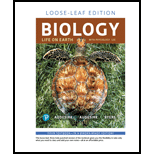
Concept explainers
The alleles responsible for antibiotic resistance in bacteria
- a. arise in response to the presence of antibiotics.
- b. are identical to the alleles responsible for pesticide resistance in insects.
- c. are present in bacterial populations that have never been exposed to antibiotics.
- d. are formed by interactions between antibiotic molecules and bacterial DNA.
Introduction:
Antibiotic resistance is the property of the bacteria to defend themselves from the effect of antibiotics. Antibiotics are the chemical compounds that are synthesized by the microorganisms and can also be synthesized in the laboratory. The bacterium posses the ability to achieve resistance against a particular antibody as its genome has the ability to encode proteins that can neutralize the antibiotic.
Answer to Problem 1MC
Correct answer:
The alleles responsible for antibiotic resistance in bacteria are present in bacterial populations that have never been exposed to antibiotics. Therefore, option (c) is correct.
Option (c) is given as “are present in bacterial populations that have never been exposed to antibiotics”.
Explanation of Solution
Justify reason for the correct statement:
The bacterial population has the gene for the antibiotic resistance in them, even if they have never been exposed to antibiotics before. The resistance is attained after the gene is activated. The gene is activated when the organism comes in contact with the antibiotic.
Hence, option (c) is correct.
Justify reasons for the incorrect statements:
Option (a) is given as “arise in response to the presence of antibiotics.”
Antibiotic resistance gene is present inside the bacteria even before it comes in contact with the antibody. Hence, it is a wrong answer.
Option (b) is given as “are identical to the alleles responsible for pesticide resistance in insects.”
The allele for pesticide resistance in insects is not identical to the antibiotic resistance in bacteria. Hence, it is a wrong answer.
Option (d) is given as “are formed by interactions between antibiotic molecules and bacterial DNA.”
The antibiotic molecules need not interact with the bacteria for the bacteria to possess the antibiotic resistance gene. Hence, it is a wrong answer.
Hence, options (a), (b), and (d) are incorrect.
The gene for the antibiotic resistance is present in the bacterial population that has not yet come in contact with the antibiotic.
Want to see more full solutions like this?
Chapter 16 Solutions
Pearson eText Biology: Life on Earth with Physiology -- Instant Access (Pearson+)
- Molecular Biology Question Please help. Thank you Explain what is meant by the term “defective virus.” Explain how a defective virus is able to replicate.arrow_forwardMolecular Biology Explain why changing the codon GGG to GGA should not be harmful. Please help . Thank youarrow_forwardStage Percent Time in Hours Interphase .60 14.4 Prophase .20 4.8 Metaphase .10 2.4 Anaphase .06 1.44 Telophase .03 .72 Cytukinesis .01 .24 Can you summarize the results in the chart and explain which phases are faster and why the slower ones are slow?arrow_forward
- Can you circle a cell in the different stages of mitosis? 1.prophase 2.metaphase 3.anaphase 4.telophase 5.cytokinesisarrow_forwardWhich microbe does not live part of its lifecycle outside humans? A. Toxoplasma gondii B. Cytomegalovirus C. Francisella tularensis D. Plasmodium falciparum explain your answer thoroughly.arrow_forwardSelect all of the following that the ablation (knockout) or ectopoic expression (gain of function) of Hox can contribute to. Another set of wings in the fruit fly, duplication of fingernails, ectopic ears in mice, excess feathers in duck/quail chimeras, and homeosis of segment 2 to jaw in Hox2a mutantsarrow_forward
- Select all of the following that changes in the MC1R gene can lead to: Changes in spots/stripes in lizards, changes in coat coloration in mice, ectopic ear formation in Siberian hamsters, and red hair in humansarrow_forwardPleiotropic genes are genes that (blank) Cause a swapping of organs/structures, are the result of duplicated sets of chromosomes, never produce protein products, and have more than one purpose/functionarrow_forwardA loss of function mutation in Pitx1 enhancers can cause (blank) Removal of Pitx1 exons and growth of ectopic hindlimbs, growth of extra ectopic forelimbs, loss of forelimb specification and development, and loss of hindlimb specification and developmentarrow_forward
- Hox1a most likely contributes to (blank) patterning in the developing embryo? Ventral, posterior, limb or anteriorarrow_forwardSelect all of the following that can help establish Hox gene expression boundaries (things that affect Hox and not things that Hox affects). Retinoic acid, anterior/posterior axis, fibroblast growth factors, vagal neural crest, and enhancersarrow_forwardEctopic expression of Hox often results in (blank) phenotypes. (Blank) transformations are characterized by the replacement of one body part/structure with another. Hoxeotic, homealoneotic, joexotic, or homeoticarrow_forward
 Biology (MindTap Course List)BiologyISBN:9781337392938Author:Eldra Solomon, Charles Martin, Diana W. Martin, Linda R. BergPublisher:Cengage Learning
Biology (MindTap Course List)BiologyISBN:9781337392938Author:Eldra Solomon, Charles Martin, Diana W. Martin, Linda R. BergPublisher:Cengage Learning Concepts of BiologyBiologyISBN:9781938168116Author:Samantha Fowler, Rebecca Roush, James WisePublisher:OpenStax College
Concepts of BiologyBiologyISBN:9781938168116Author:Samantha Fowler, Rebecca Roush, James WisePublisher:OpenStax College Human Heredity: Principles and Issues (MindTap Co...BiologyISBN:9781305251052Author:Michael CummingsPublisher:Cengage Learning
Human Heredity: Principles and Issues (MindTap Co...BiologyISBN:9781305251052Author:Michael CummingsPublisher:Cengage Learning Biology: The Dynamic Science (MindTap Course List)BiologyISBN:9781305389892Author:Peter J. Russell, Paul E. Hertz, Beverly McMillanPublisher:Cengage Learning
Biology: The Dynamic Science (MindTap Course List)BiologyISBN:9781305389892Author:Peter J. Russell, Paul E. Hertz, Beverly McMillanPublisher:Cengage Learning





